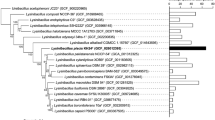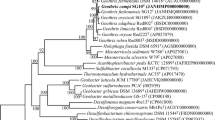Abstract
Acetobacterium woodii, Acetogenium kivui, Clostridium aceticum, C. acidiurici, C. cylindrosporum, C. formicoaceticum, C. thermoaceticum, Eubacterium limosum, andPeptococcus glycinophilus were characterized by oligonucleotide cataloging of their 16S ribosomal RNA to determine whether the ability to synthesize acetate from CO2 is a phylogenetic trait. The ability to synthesize acetate from CO2 apparently is not a valid phylogenetic marker. TheEubacterium andPeptococcus species examined here are less related to other species in their genera than they are to different species ofClostridium. TheEubacterium species examined here show little relatedness to the genusPropionibacterium. The acetogenic eubacteria belong to the phylogenetic group defined basically by the Gram-positive sporeforming anaerobes.
Similar content being viewed by others
Literature Cited
Balch, W. E., Fox, G. E., Magrum, L. J., Woese, C. R., Wolfe, R. S. 1979. Methanogens: Reevaluation of a unique biological group. Microbiological Reviews43:260–296.
Balch, W. E., Schoberth, S., Tanner, R. S., Wolfe, R. S. 1977.Acetobacterium, a new genus of hydrogen-oxidizing, carbon dioxide-reducing, anaerobic bacteria. International Journal of Systematic Bacteriology27:355–361.
Braun, M., Mayer, F., Gottschalk, G. 1981.Clostridium aceticum (Wieringa), a microorganism producing acetic acid from molecular hydrogen and carbon dioxide. Archives of Microbiology128:288–293.
Fox, G. E., Pechman, K. R., Woese, C. R. 1977. Comparative cataloging of 16S ribosomal ribonucleic acid: Molecular approach to procaryotic systematics. International Journal of Systematic Bacteriology27:44–57.
Fox, G. E., Stackebrandt, E., Hespell, R. B., Gibson, J., Maniloff, J., Dyer, T. A., Wolfe, R. S., Balch, W. E., Tanner, R. S., Magrum, L. J., Zablen, L. B., Blakemore, R., Gupta, R., Bonen, L., Lewis, B. J., Stahl, D. A., Luehrsen, K. R., Chen, K. N., Woese, C. R. 1980. The phylogeny of prokaryotes. Science209:457–463.
Johnson, J. L., Francis, B. S. 1975. Taxonomy of the clostridia: Ribosomal ribonucleic acid homologies among the species. Journal of General Microbiology88:229–244.
Leigh, J. A., Mayer, F., Wolfe, R. S. 1981.Acetogenium kivui, a new thermophilic hydrogen-oxidizing, acetogenic bacterium. Archives of Microbiology129:275–280.
Ljungdahl, L. G., Andreesen, J. R. 1976. Reduction of CO2 to acetate in homoacetate fermenting clostridia and the involvement of tungsten in formate dehydrogenase, pp. 163–172. In: Schlegel, H. G., Gottschalk, G., Pfennig, N. (eds.), Microbial production and utilization of gases. Göttingen: E. Goltze K. G.
Ljungdahl, L. G., Wood, H. G. 1969. Total synthesis of acetate from CO2 by heterotrophic bacteria. Annual Review of Microbiology23:515–538.
Moore, W. E. C., Holdeman, L. V. 1974.Propionibacteriaceae, pp. 633–657. In: Buchanian, R. E., Gibbons, N. E. (eds.), Bergey's manual of determinative bacteiology, 8th ed. Baltimore: Williams & Wilkins.
Pechman, K. R. 1976. Investigation of the phylogenetic relationship ofSporosarcina ureae to members of theBacillaceae using primary structural characterization of 16S ribosomal ribonucleic acids. Ph.D. thesis. University of Illinois, Urbana, Illinois.
Sharak Genthner, B. R., Davis, C. L., Bryant, M. P. 1981. Features of rumen and sewage sludge strains ofEubacterium limosum, a methanol- and H2−CO2-utilizing species. Applied and Environmental Microbiology42:12–19.
Stackebrandt, E., Woese, C. R. 1981. Towards a phylogeny of the actinomycetes and related organisms. Current Microbiology5:197–202.
Tanner, R. S., Stackebrandt, E., Fox, G. E., Woese, C. R. 1981. A phylogenetic analysis ofAcetobacterium woodii, Clostridium barkeri, Clostridium butyricum, Clostridium lituseburense, Eubacterium limosum, andEubacterium tenue. Current Microbiology5:35–38.
Tanner, R. S., Wolfe, R. S., Ljungdahl, L. G. 1978. Tetrahydrofolate enzyme levels inAcetobacterium woodii and their implication in the synthesis of acetate from CO2. Journal of Bacteriology134:668–670.
Uchida, T., Bonen, L., Schaup, H. W., Lewis, B. J., Zablen, L., Woese, C. R. 1974. The use of ribonuclease U2 in RNA sequence determination. Some corrections in the catalog of oligomers produced by ribonuclease T1 digestion ofEscherichia coli 16S ribosomal RNA. Journal of Molecular Evolution3:63–77.
Waber, L. J., Wood, H. G. 1979. Mechanism of acetate synthesis from CO2 byClostridium acidiurici. Journal of Bacteriology140:468–478.
Woese, C. R., Sogin, M., Stahl, D., Lewis, B. J., Bonen, L. 1976. A comparison of the 16S ribosomal RNAs from mesophilic and thermophillic bacilli: Some modifications in the Sanger method for RNA sequencing. Journal of Molecular Evolution7:197–213.
Wolin, E. A., Wolin, M. J., Wolfe, R. S. 1963. Formation of methane by bacterial extracts. Journal of Biological Chemistry238:2882–2886.
Zablen, L. 1976. Procaryotic phylogeny by ribonucleic acid sequence homology. Ph.D. thesis. University of Illinois, Urbana, Illinois.
Author information
Authors and Affiliations
Rights and permissions
About this article
Cite this article
Tanner, R.S., Stackebrandt, E., Fox, G.E. et al. A phylogenetic analysis of anaerobic eubacteria capable of synthesizing acetate from carbon dioxide. Current Microbiology 7, 127–132 (1982). https://doi.org/10.1007/BF01568961
Issue Date:
DOI: https://doi.org/10.1007/BF01568961




